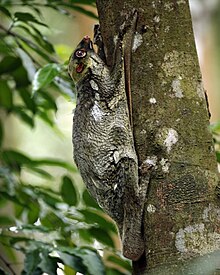By Mindy Weisberger, Senior
Writer | August 10, 2016 03:06pm ET
Gliding mammals called colugos
sail through the air using membranes that stretch between their limbs and
resemble the wings of bats. But these furry gliders are actually a sister group
to primates, a new study finds.
 Colugos are tree dwellers, with
limbs connected by flaps of skin known as a patagium, or gliding
membrane. These critters live in southeast Asia, and adults measure
about 14 to 16 inches (35 to 40 centimeters) long and weigh around 2 to 4 lbs.
(1 to 2 kilograms).
Colugos are tree dwellers, with
limbs connected by flaps of skin known as a patagium, or gliding
membrane. These critters live in southeast Asia, and adults measure
about 14 to 16 inches (35 to 40 centimeters) long and weigh around 2 to 4 lbs.
(1 to 2 kilograms).
Scientists have debated colugos'
lineage for the past century. Some experts had linked them to tree shrews, with
which colugos share certain physical traits. But recent genetic sequencing
revealed that colugos are more closely related to primates — the group that
includes great apes and humans. This finding could help scientists develop a
clearer picture of evolution in the earliest primates, the researchers
suggested.
There are only two known colugo
species — sometimes referred to as "flying
lemurs," though they are not lemurs and do not fly — and they
are poorly understood for a number of reasons, according to study co-author
William Murphy, a professor in the Department of Veterinary Integrative
Biosciences at Texas A&M University.
Colugos' unusual gliding
adaptations have hampered efforts to keep them in captivity, Murphy told Live
Science in an email. And their nocturnal lifestyle high in the tree canopies
makes it difficult for scientists to observe and track them in the wild.
"Only a few publications
have documented their [colugos'] ecology and habits," Murphy said.













No comments:
Post a Comment
You only need to enter your comment once! Comments will appear once they have been moderated. This is so as to stop the would-be comedian who has been spamming the comments here with inane and often offensive remarks. You know who you are!